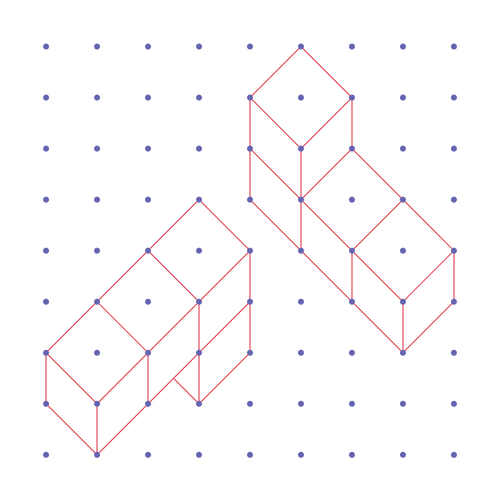E1.2 Compose and decompose various structures, and identify the two-dimensional shapes and three-dimensional objects that these structures contain.
Activity 1: Three-Dimensional Structure
Instructions
Provide teams with three-dimensional objects in the shape of a cube, prism, pyramid, sphere, and cylinder, made from a variety of materials (for example, wood, plastic, foam) and varying in size and orientation.
Have teams create a structure with the three-dimensional objects.
Allow time for students to create the structure.
Teacher Moves
Circulate and ask students to explain their process and their choices of three-dimensional objects.
Ask teams to present their structure and invite other teams to name the three-dimensional objects and the two-dimensional shapes of the visible faces of the structure.
Source: translated from Guide d’enseignement efficace des mathématiques de la 1re à la 3e année, Géométrie et sens de l'espace, p. 48-49.
Activity 2: Assembling Three-Dimensional Objects (Composing and Decomposing Geometric Shapes)
Instructions
Form teams of two.
Provide each team with interlocking cubes.
Have students create as many unique three-dimensional objects as possible with four cubes.
Compare team results.
Teacher Moves
Point out that two three-dimensional objects formed with the same number of cubes and assembled in the same way, but having a different orientation, are not necessarily unique.
Example

Source: translated from Guide d’enseignement efficace des mathématiques de la 1re à la 3e année, Géométrie et sens de l'espace, p. 52-53.
Examples of Activities to Do at Home
Construction
We have studied the cube, the cone, the sphere, the pyramid, and the prism in class. Give your child empty boxes, blocks, and recycling box items, and challenge them to build a tall structure.
- Let them discover that a stable structure needs a solid foundation.
- Ask them which shapes are easiest to stack. Ask them to justify their answer.
Geometric Recycling
We have been studying the following two-dimensional shapes in class: the square, the rectangle, the triangle, the circle, the rhombus, the pentagon (five-sided shape), the hexagon (six-sided shape), the octagon (eight-sided shape), and the following three-dimensional objects: the cube, the cylinder, the cone, the pyramid, the sphere and the prism. Before putting an empty cardboard box in the recycling bin, ask your child to determine what type of three-dimensional object it is. Then have them cut out the box to determine the number and type of two-dimensional shapes that make it up.
Source: translated from L'@telier - Ressources pédagogiques en ligne (atelier.on.ca), p. 2 and 5.
